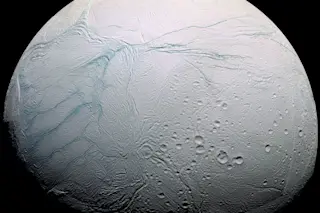Saturn’s icy moon Enceladus sports a series of parallel, evenly spaced stripes at its south pole. Scientists believe these stripes are long fissures in the icy shell that covers the moon's subsurface liquid water ocean. But astronomers still aren’t sure how these fissures formed, why they’re so evenly spaced or why other icy worlds don’t have them.
Now, a team of researchers has proposed an explanation that could account for all the major questions about this series of fissures. The team published their findings Monday in the journal Nature Astronomy.
Scientists discovered the stripes when the Cassini mission to Saturn noticed something unusual at the moon’s south pole. Plumes were erupting along a series of features that researchers dubbed “tiger stripes.”
"People have been interested in this ever since that was discovered, and it's been in kind of the back of everyone's mind," said Douglas Hemingway, a planetary scientist at ...














